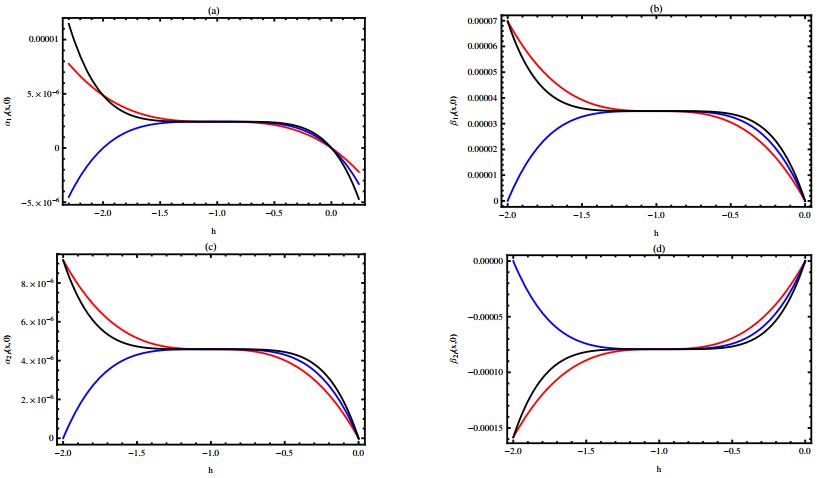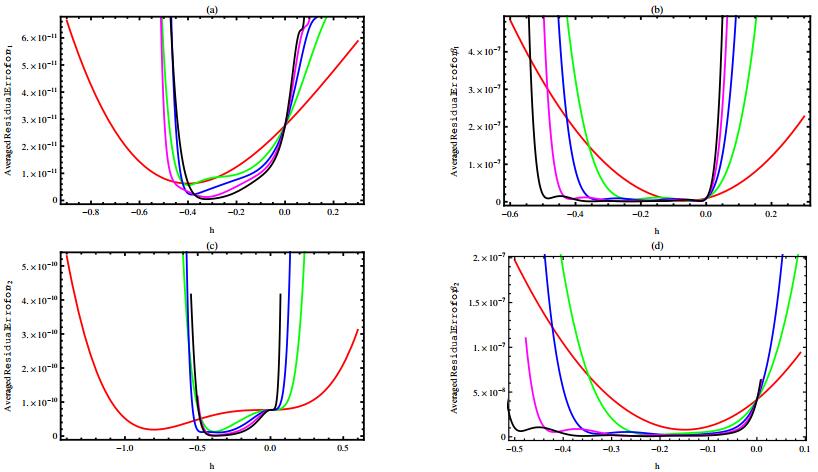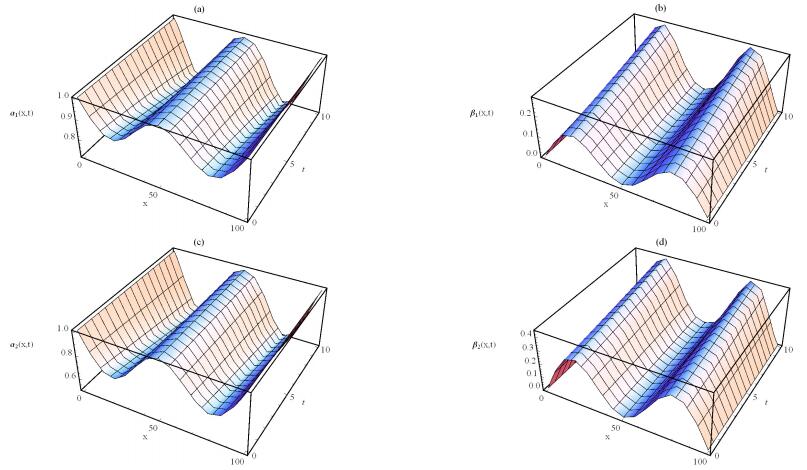1.
Introduction
Let ϕ:I⊆R→R be a convex function and α,β∈I with α<β, then the following inequality holds,
which is well known as Hermite-Hadamard's inequality [1] for convex functions. Both inequalities hold in the reversed direction if ϕ is concave.
Convex function is an important function in mathematical analysis and has been applied in many aspects [2,3]. With the extension of the definition of convex function, Hermite-Hadamard's inequality has been deeply studied. Some improvement and generalizations for Hermite-Hadamard's inequality (1.1) can been found in the references [4,5,6,7,8,9,10,11,12].
In [11], İşcan gave the definition of harmonically convexity as follows:
Definition 1. Let I⊂R∖{0} be a real interval. A function ϕ:I→R is said to be harmonically convex, if
for all x,y∈I and t∈[0,1]. If the inequality in (1.2) is reversed, then ϕ is said to be harmonically concave.
In recent years, many researchers presented many kinds of fractional calculus by different methods and explored their applications. For example, Riemann-Liouville fractional integrals and its applications in inequalities [13,14,15,16]. Recently, Yang stated the theory of local fractional calculus on Yang's fractal sets systematically in [17,18,19]. Local fractional calculus can explain the behavior of continuous but nowhere differentiable function. In view of the special advantages of local fractional calculus, more and more researchers extended their studies to Yang's fractal space, see [20,21,22,23,24,25,26,27,28,29].
In [22], Sun introduced the definition of the generalized harmonically convex function on Yang's fractal sets as follows:
Definition 2. Let I⊂R∖{0} be a real interval. A function ϕ:I→Rϵ(0<ϵ≤1) is said to be generalized harmonically convex, if
for all x,y∈I and t∈[0,1]. If the inequality in (1.3) is reversed, then ϕ is said to be generalized harmonically concave. The sign ϵ represents the fractal dimension.
Example 1. Let ϕ:(0,∞)→Rϵ and ψ:(−∞,0)→Rϵ, then ϕ(x)=xϵ is a generalized harmonically convex function and ψ(x)=xϵ is a generalized harmonically concave function.
The following result related to Hermite-Hadamard's inequalities holds.
Theorem 1. [22] Let ϕ:I⊂R∖{0}→Rϵ be a generalized harmonically convex function on fractal space and α,β∈I with α<β. If ϕ(x)∈I(ϵ)x[α,β], then
Based on the theory of local fractional calculus and the definition of the generalized harmonically convex function on Yang's fractal sets, the main aim of this paper is using a new integral identity and monotonicity of functions to establish some new Hermite-Hadamard type inequalities involving local fractional calculus.
2.
Preliminaries
Let Rϵ(0<ϵ≤1) be ϵ-type set of the real line numbers on Yang's fractal sets, and give the following operation rules, see[17,18]. The sign ϵ represents the fractal dimension, not the exponential sign.
If αϵ,βϵ,γϵ∈Rϵ, then addition and multiplication operations satisfy
(a) αϵ+βϵ∈Rϵ, αϵβϵ∈Rϵ,
(b) αϵ+βϵ=βϵ+αϵ=(α+β)ϵ=(β+α)ϵ,
(c) αϵ+(βϵ+γϵ)=(α+β)ϵ+γϵ,
(d) αϵβϵ=βϵαϵ=(αβ)ϵ=(βα)ϵ,
(e) αϵ(βϵγϵ)=(αϵβϵ)γϵ,
(f) αϵ(βϵ+γϵ)=αϵβϵ+αϵγϵ,
(g) αϵ+0ϵ=αϵ, αϵ+(−α)ϵ=0ϵ and αϵ1ϵ=1ϵαϵ=αϵ,
(h) (α−β)ϵ=αϵ−βϵ.
Definition 3. [18,19] If there exists the relation
with |x−x0|<δ, for ε,δ>0 and ε,δ∈R.Then the function ϕ(x) is called local fractional continuous at x0. If ϕ(x) is local fractional continuous on (α,β), we denote by ϕ(x)∈Cϵ(α,β).
Definition 4. [17,19] Supposing that ϕ(x)∈Cϵ(α,β), the local fractional derivative of ϕ(x) of order ϵ at x=x0 is defined by
For any x∈(α,β), there exists ϕ(ϵ)(x)=D(ϵ)x, denoted by ϕ(ϵ)(x)∈D(ϵ)x(α,β). Dϵ(α,β) is called ϵ-local fractional derivative set. If there exits ϕ((n+1)ϵ)(x)=(n+1)times⏞Dϵx⋅⋅⋅Dϵxϕ(x) for any x∈I⊆R, then we denote ϕ∈D(n+1)ϵ(I), where n=0,1,2,⋅⋅⋅
Definition 5. [17,19] Let ϕ(x)∈Cϵ[α,β]. The local fractional integral of function ϕ(x) of order ϵ is defined by
where α=t0<t1<⋅⋅⋅<tN−1<tN=β,[tj,tj+1] is a partition of the interval [α,β], Δtj=tj+1−tj,Δt=max{Δt0,Δt1⋅⋅⋅ΔtN−1}.
Note that αI(ϵ)αϕ(x)=0, and αI(ϵ)βϕ(x)=−βI(ϵ)αϕ(x) if α<β. We denote ϕ(x)∈I(ϵ)x[α,β] if there exits αI(ϵ)xϕ(x) for any x∈(α,β).
Lemma 1. [17]
(1) Suppose that ϕ(x)=φ(ϵ)(x)∈Cϵ[α,β], then
(2) (Local fractional integration by parts)
Suppose that ϕ(x),φ(x)∈Dϵ(α,β), and ϕ(ϵ)(x),φ(ϵ)(x)∈Cϵ[α,β], then
Lemma 2. [17] Suppose that ϕ(x)∈Cϵ[α,β] and α<γ<β, then
Lemma 3. [17]
Lemma 4. [18,30] (Generalized Hölder's inequality) Let ϕ,φ∈Cϵ[α,β],p,q>1, with 1p+1q=1, then
Lemma 5. [17]
Let us introduce the special functions on Yang's fractal sets as follows:
(1) The generalized Beta function is given by
(2) The generalized hypergeometric function is given by
3.
Main results
For convenience, we use the symbol At to denote tα+(1−t)β in the following sections.
Lemma 6. Let I⊂(0,∞) be an interval, ϕ:I∘→Rϵ (I∘ is the interior of I) such that ϕ∈Dϵ(I∘) and ϕ(ϵ)∈Cϵ(α,β) for α,β∈I∘ with α<β. Then the following equality holds
where
Proof. Calculating I1,I2, from Lemma 1(1), we get
and
Calculating I3, by the local fractional integration by parts, we have
Using changing variable with x=αβAt, we have
Adding I1−I3, the desired result is obtained. This completes the proof.
Theorem 2. Let I⊂(0,∞) be an interval, ϕ:I∘→Rϵ (I∘ is the interior of I) is an increasing function on I∘ such that ϕ∈Dϵ(I∘) and ϕ(ϵ)∈Cϵ[α,β] for α,β∈I∘ with α<β. If |ϕ(ϵ)|q is generalized harmonically convex on [α,β] for some fixed q>1, then for all x∈[α,β], the following local fractional integrals inequality holds,
where
Proof. Since ϕ is an increasing function on I∘, and 0<α<2αβα+β<β, we can obtain
From the proof of Lemma 6, we have
Taking modulus in equality (3.1), we obtain
From Lemma 6, using the property of the modulus and the generalized Hölder's inequality, we have
Since |ϕ(ϵ)|q is generalized harmonically convex on [α,β], thus
By calculating, we get
Similarly, we get
and
From (3.4)–(3.9), we get inequality (3.2). This completes the proof.
Theorem 3. Let I⊂(0,∞) be an interval, ϕ:I∘→Rϵ is an increasing function on I∘ such that ϕ∈Dϵ(I∘) and ϕ(ϵ)∈Cϵ[α,β] for α,β∈I∘ with α<β. If |ϕ(ϵ)|q is generalized harmonically convex on [α,β], q>1,1p+1q=1, then for all x∈[α,β], the following local fractional integrals inequality holds.
Proof. From inequality (3.4), we have
From Lemma 6, using the property of the modulus and the generalized Hölder's inequality, we have
Since |ϕ(ϵ)|q is generalized harmonically convex on [α,β], we can get
By calculating, we have
and
Thus, combining (3.11)–(3.16), we obtain the required inequality. The proof is completed.
Theorem 4. Let I⊂(0,∞) be an interval, ϕ:I∘→Rϵ is an increasing function on I∘ such that ϕ∈Dϵ(I∘) and ϕ(ϵ)∈Cϵ[α,β] for α,β∈I∘ with α<β. If |ϕ(ϵ)|q is generalized harmonically convex on [α,β], q>1,1p+1q=1, then for all x∈[α,β], the following local fractional integrals inequality holds.
Proof. From Lemma 6, using the generalized Hölder's inequality and the generalized harmonically convexity of |ϕ(ϵ)|q, we have
By calculating, we have
and
From (3.11) in Theorem 3, combining (3.18)–(3.21), we obtain the required inequality. The proof is completed.
Theorem 5. Let I⊂(0,∞) be an interval, ϕ:I∘→Rϵ is an increasing function on I∘ such that ϕ∈Dϵ(I∘) and ϕ(ϵ)∈Cϵ[α,β] for α,β∈I∘ with α<β. If |ϕ(ϵ)|q is generalized harmonically convex on [α,β], q>1,1p+1q=1, then for all x∈[α,β], the following local fractional integrals inequality holds.
Proof. Note that (α−β)ϵ=αϵ−βϵ. From Lemma 6, using the generalized Hölder's inequality and the generalized harmonically convexity of |ϕ(ϵ)|q, we have
By calculating, we have
Similarly,
And
From (3.11) in Theorem 3, combining (3.23)–(3.26), we obtain the required inequality. The proof is completed.
4.
Applications to special means
We consider the following ϵ-type generalized special means of the real line numbers αϵ,βϵ with α<β on Yang's fractal sets.
(1) The generalized arithmetic mean
(2) The generalized p-logarithmic mean
(3) The generalized geometric mean
(4) The generalized harmonic mean
Consider the function ϕ:(0,∞)→Rϵ, ϕ(x)=Γ(1+kϵ)Γ(1+(k+1)ϵ)x(k+1)ϵ, x>0,k≥1 and q≥1. Because the function φ(x)=|ϕ(ϵ)(x)|q=xkqϵ is generalized convex and nondecreasing on (0,∞), by Proposition 3.3 in [22], the function φ(x) is generalized harmonically convex on (0,∞).
Let ϕ(x)=Γ(1+kϵ)Γ(1+(k+1)ϵ)x(k+1)ϵ, x>0,k>1 and q>1. Then
Proposition 1. From Theorem 2, we obtain the following inequality
where Kϵ1(α,β),Kϵ2(α,β) and Kϵ3(α,β) as in Theorem 2.
Proposition 2. From Theorem 3, we obtain the following inequality
where 1p+1q=1,q>1.
Proposition 3. From Theorem 4, we obtain the following inequality
where 1p+1q=1,q>1.
Proposition 4. From Theorem 5, we obtain the following inequality
where 1p+1q=1,q>1.
5.
Conclusions
In this paper, the research on Hermite-Hadamard type inequalities is extended to Yang's fractal space. By using the definitions of generalized harmonically convex function and the theory of local fractional calculus, we construct some new Hermite-Hadamard type integral inequalities for monotonically increasing functions with generalized harmonically convexity. Some applications related to the special mean are established by using the obtained inequalities, which shows that our results have certain application significance. Our research may inspire more scholars to further explore Hermite-Hadamard type integral inequalities on Yang's fractal sets.
Acknowledgments
This work is supported by the Natural Science Foundation of Hunan Province (No. 2020JJ4554) and Scientific Research Project of Hunan Provincial Education Department (No. 18B433).
Conflict of interest
This work does not have any conflicts of interest.
















 DownLoad:
DownLoad: